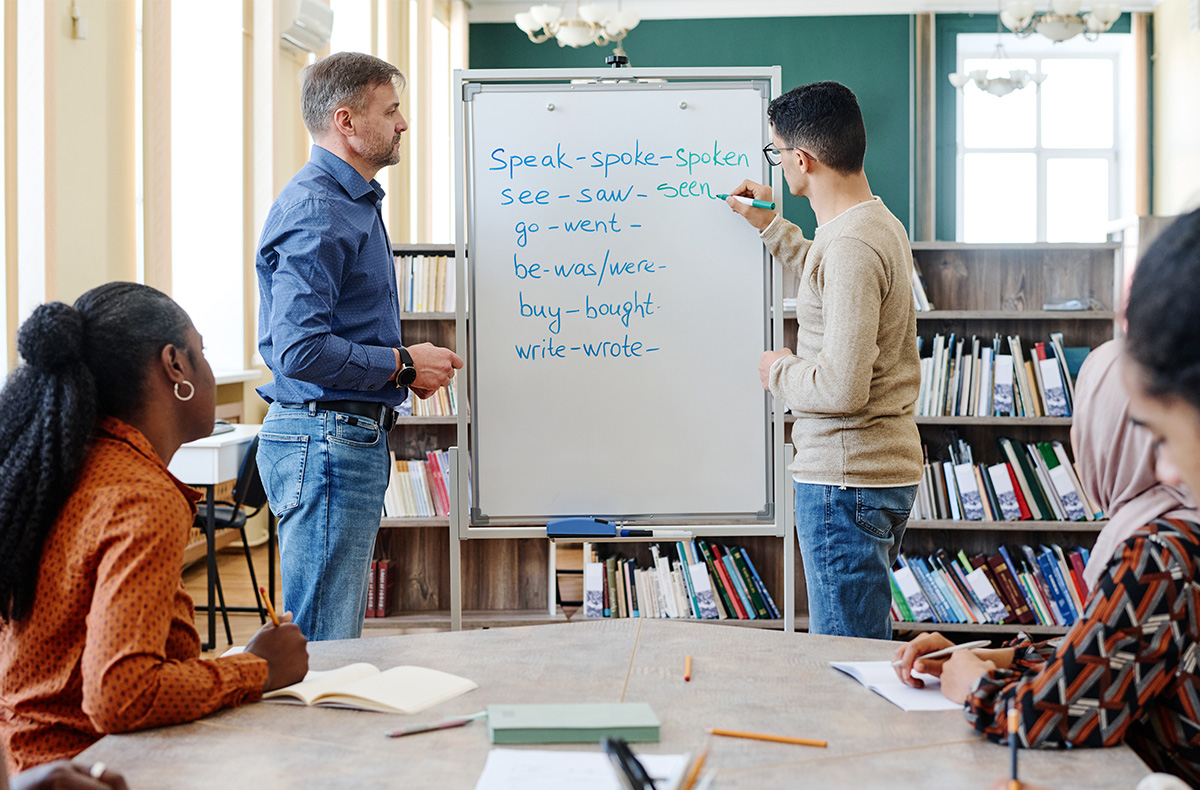As students, many of us took part in some type of foreign language instruction at school, and depending on your age and country, this could have ranged from incomprehensible teacher lectures to singing songs, to intense grammar drilling. In the world of education, second language acquisition philosophies and practices change at a rapid clip, and the new breakthrough methodology being touted today may be derided and discarded tomorrow. Below are 12 of the most prominent language teaching methods, namely in the area of teaching English as a foreign language. They are presented here in approximate order of appearance in major foreign language curricula.
Grammar-Translation
This method has been around since the days of Ancient Greece and Rome, and it focuses on the study of a language’s grammar rules and the translation of vocabulary words. This style typically involves memorizing verb conjugations and directly translating words and phrases from one language to the other. It has fallen largely out of favor, though parts of it are still employed in more traditional schools.
Direct Method
This approach broke from traditional methods, as it focuses largely on speaking and listening, does not use learners’ native languages, and aims to provide a totally immersive experience. It has proven very effective at helping students learn to converse and communicate, though this framework can be challenging for younger and beginning learners, as they can feel lost and overwhelmed at first.
Audio-Lingual Method
This method involves listening and repeating, and it may sound familiar to older students – “Okay, class. Repeat after me…” The purpose is to develop speaking and listening skills via repetition and close attention to audiolingual distinctions. A heavy emphasis is put on obtaining a “native speaker accent.” An overreliance on this system can produce students who can speak beautifully, but have no idea what they are saying.
Total Physical Response (TPR)
This style involves learning via physical movement and activity. For example, the teacher may say, “Touch your nose,” and students all touch their noses, or the teacher may lead a game of Simon Says or have students act out various scenarios. Music and dance are commonly seen with this style, and while older students may be more reluctant to jump around the classroom, young learners typically love the engaging and entertaining play-style activities.
Community Language Learning (CLL)
CLL puts a strong focus on establishing the relationships between teachers and students. Teaching/Learning is seen as more of a collaborative effort between the teacher and students, and though the teacher aims to model proper language skills, the classroom community and fellow students are also strong contributors to learning.
Suggestopedia
The learning environment itself plays a major role here, and students are encouraged to enjoy the new language via music, acting, and freely expressing themselves as best they can. Background music is often played during class, and students may lounge in armchairs or sprawl out on the floor. The teacher may also lead breathing and even meditation activities at the beginning of class. There is a limited focus on grammar rules and more of an emphasis on a comfortable language-learning experience.
The Natural Approach
This has been a popular method since the ‘80s, and its intention is for learners to acquire the new language naturally, as they did in their native language. Students gain new vocabulary and grammar understanding in the same ways they did as young children, via storytelling, listening, and exploring. This method has prominent supporters, such as Stephen Krashen, who believe that the intentionally limited focus on grammar and writing is a net positive to overall learning
Task-Based Language Teaching (TBLT)
This is a system in which intermediate and/or older students are given specific tasks to complete, such as writing a letter, engaging in an interview, or ordering food in a restaurant. This method is popular for business English students who have specific situations and contexts they need to master.
Content-Based Language Teaching (CBLT)
This system focuses on teaching specific content, such as History or Science topics, in the second language. As language skills are reinforced more indirectly, this method is more suitable for advanced learners.
The Silent Way
In this method, it is the teacher who is “silent,” and students work to solve problems or puzzles, either independently or in collaboration with one another. The teacher is more of a guide who presents various challenges, and the focus is on autonomy and independent study. Critics claim that it may lack structure or be too abstract to achieve long-lasting learning.
Communicative Language Teaching (CLT)
As the name suggests, this method puts a heavy emphasis on communication skills, and speaking and listening skills are developed extensively via oral activities, dialoguing, and acting out real-life situations. Group discussions are promoted here, and it is more appropriate for intermediate to advanced learners.
The Lexical Approach
This is a relatively modern approach that rose to prominence in the early 2000s, largely thanks to the work of Michael Lewis. Rather than directly translating individual words, it looks at commonly used “lexical phrases” or “chunks” that are often found together and in different scenarios. Students gain a greater understanding of the language via extensive reading and role-playing.
These are but twelve of the more common teaching methods, and a good teacher will select not one, but many of these systems, weaving activities from the different methodologies together into a comprehensive and engaging class curriculum.


